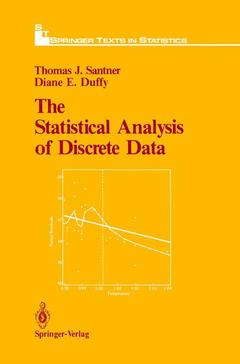Description
The Statistical Analysis of Discrete Data, 1989
Springer Texts in Statistics Series
Authors: Santner Thomas J., Duffy Diane E.
Language: English
Subjects for The Statistical Analysis of Discrete Data:
Approximative price 52.74 €
In Print (Delivery period: 15 days).
Add to cart
Publication date: 10-2012
372 p. · 15.5x23.5 cm · Paperback
372 p. · 15.5x23.5 cm · Paperback
Description
/li>Contents
/li>
The Statistical Analysis of Discrete Data provides an introduction to cur rent statistical methods for analyzing discrete response data. The book can be used as a course text for graduate students and as a reference for researchers who analyze discrete data. The book's mathematical prereq uisites are linear algebra and elementary advanced calculus. It assumes a basic statistics course which includes some decision theory, and knowledge of classical linear model theory for continuous response data. Problems are provided at the end of each chapter to give the reader an opportunity to ap ply the methods in the text, to explore extensions of the material covered, and to analyze data with discrete responses. In the text examples, and in the problems, we have sought to include interesting data sets from a wide variety of fields including political science, medicine, nuclear engineering, sociology, ecology, cancer research, library science, and biology. Although there are several texts available on discrete data analysis, we felt there was a need for a book which incorporated some of the myriad recent research advances. Our motivation was to introduce the subject by emphasizing its ties to the well-known theories of linear models, experi mental design, and regression diagnostics, as well as to describe alterna tive methodologies (Bayesian, smoothing, etc. ); the latter are based on the premise that external information is available. These overriding goals, to gether with our own experiences and biases, have governed our choice of topics.
1 Introduction.- 2 Univariate Discrete Responses.- 3 Loglinear Models.- 4 Cross-Classified Data.- 5 Univariate Discrete Data with Covariates.- Appendix 1. Some Results from Linear Algebra.- Appendix 2. Maximization of Concave Functions.- Appendix 3. Proof of Proposition 3.3.1 (ii) and (iii).- Appendix 4. Elements of Large Sample Theory.- Problems.- References.- List of Notation.- Index to Data Sets.- Author Index.
© 2024 LAVOISIER S.A.S.
These books may interest you

Categorical Data Analysis 150.41 €



